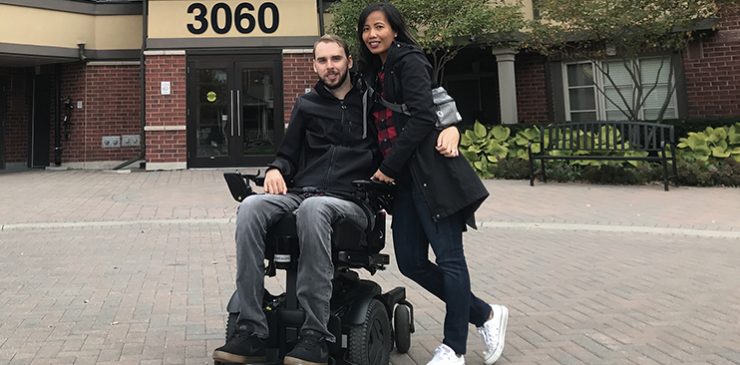I enjoy working with buyers and helping them find a home where they can live comfortably and independently. This is one of the most gratifying parts of my job.
In November 2020, Sean and his wife, Lhanie, connected with me to ask for my advice and guidance on buying a condo that could be modified for Sean’s needs. I’m happy to report that the couple have found a home that works for them. Their journey highlights many of the challenges that clients with disabilities face when searching for a suitable condo.
Sean’s Story
In August 2013, Sean and a few of his friends were at a beach on Lake Huron in Grand Bend for the long weekend. Just before they decided to pack up and leave they decided to go for one last swim. As Sean ran into the water it started to get deeper and he dove headfirst into an unexpected sandbar, resulting in a C4-5 spinal fracture. Thankfully, his friends were nearby and pulled him from the water very quickly, but his life changed instantly, and he now has quadriplegia with limited movement in his arms and hands.
Love At First Pitch
Lhanie and Sean met in the summer of 2016 when Lhanie, who is a PSW, was called in as a one-time replacement for Sean’s regular PSW. Sean happened to be watching the Blue Jays game that day and they immediately connected through their mutual love for the Jays. You could call it love at first pitch. They were married on October 16, 2020. Lhanie moved in with Sean who was living in his parent’s home that had been modified after his accident.
Mortgage Approval
The first thing I encouraged Sean and Lhanie to do in their search for a home was obtain a mortgage pre-approval. This was necessary to determine their budget and also help to eliminate any financing surprises later on.
They took a very practical approach to their financing. After making some initial inquiries in 2020, they decided to wait a few extra months because Lhanie had just started a new job, and the bank wanted to see a longer job history with her new employer. In August 2021, with their mortgage pre-approval in place, we started actively looking at condo options.
Entrance Solution
Not all entrances are created equal. Some condo buildings do not have wheelchair accessible entrances and many lack power door openers. I often look at a picture of the main building entrance to determine if it is accessible. One of the condos that Sean and Lhanie were interested in seeing had an elaborately landscaped ramp, but it did not have a power door opener and had a round doorknob that required a key to unlock it. Unfortunately, this condo was ruled out before even getting through the front door.
Suite Door Opener
Individual owners are responsible for the cost and installation of a power door opener to their suite. However, because changes are often required to the hallway side of the door (which is the condo corporation’s responsibility), homeowners need to get permission from the condo board before installing one. Inside the condo, it’s important to ensure there is enough space above the door to accommodate the opener and to determine where the closest electrical outlet is to provide power. Since Sean and Lhanie’s condo did not have a power door opener, I recommended that they install one with a remote control. This remote can be added to Sean’s key chain or affixed to his chair for easy reach. In the Spring 2018 edition of Outspoken, I provide more insight about door openers.
Balcony Access
Balcony access is often near the top of my buyer’s wish list, but very few condo balconies have low thresholds and wide enough doors for wheelchair users. If the balcony is large enough, it is sometimes possible to install a ramp; however, raising the floor level on the balcony can impact the railing height and make it too low. When clients do wish to make changes to their balconies, I always recommend consulting the Property Manager to find out what alterations are permitted.
In Sean and Lhanie’s case, thebalcony is too small for Sean to access with his power chair. They decided that although balcony access would be nice to have, it wasn’t a deal-breaker for them.

Door Width
Interior doors can easily be widened by using offset hinges. These hinges allow the door to swing open and in line with the door frame which can provide an extra 2 inches (5 cm) to the doorway.
If space allows, door frames can be widened and swing doors can be replaced with pocket doors.
Sean’s power wheelchair fits through the interior doorways in their new condo, but they may still decide to widen them to avoid the inevitable door frame scratches that are common with using a wheelchair.
Bathroom Solution
For Sean and Lhanie, a spacious accessible bathroom with a roll-in shower was a must. Since most condos are built with small bathrooms, we needed to find space to expand the bathroom. An accessible bathroom is the number one home modification that my clients need. The specific configuration will vary depending on the individual or family needs.
Sean and Lhanie’s bathroom modification will be accomplished by incorporating some of the space from the walk-in closet that adjoins the bathroom. Over the years, I’ve found that bathrooms that share a wall with a closet are often the perfect combination for creating an accessible bathroom. That being said, additional space is just part of the puzzle – the location of plumbing pipes and drains need to be considered too.
Kitchen and Laundry Rooms
The kitchen and laundry rooms are both important areas in the home. Whether these rooms need to be fully wheelchair accessible often depends on who does the food preparation and laundry. If you enjoy cooking, then you’ll want an accessible kitchen. And if you take care of your own laundry, then you’ll need a washer and dryer that you can easily access.
Finding a kitchen with a roll-up eating area or breakfast bar is ideal. This area can double as a food preparation area for someone in a seated position. The kitchen counter in Sean and Lhanie’s condo extends out just far enough for Sean to roll under, and the peninsula-style counter set up is ideal for him to manoeuvre around.
One of the most creative counters that I’ve seen was a very large butcher block that was mounted on a hydraulic post that could be raised to standing height or lowered to sitting height depending on who was using it.
Bedroom Size
Bedrooms in most new condos are very small. You’ll need to ensure that there is enough space for your wheelchair, bed and furniture. Moreover, if you use a ceiling track, you will also need to be aware of bulkheads in the ceiling that would prevent the lift from being installed.
Sean uses a portable Hoyer lift which has a wide base. His new primary bedroom is large enough to accommodate the lift and still maintain a clear path to the ensuite bathroom.
Parking Solution
Finding a parking spot for an accessible vehicle can be difficult. Most buildings have designated accessible parking spots, but they are intended for short-term use. Ideally, you’ll want to park underground in the winter to avoid having to clear off snow and ice. And if you drive a modified vehicle, you’ll need a wider parking spot and possibly additional ceiling height.
Sean drives a Toyota Sienna modified van which has a height of approximately 6’ 5”. We had to rule out a number of condo buildings because the parking garage ceiling height was too low. The condo that Sean and Lhanie purchased came with two regular-sized parking spots, but the building has both indoor and outdoor accessible parking spots that can be rented month to month. After a very careful test drive through the parking garage, we determined that the height was compatible with his van and he will be able to access both indoor and outdoor parking.
If you are considering making the move to a condo, keeping some of these things in mind will help make it a smoother process.
Congratulations to Sean and Lhanie on finding a home that works for them!
 Jeffrey Kerr, Broker, Barrier Free Real Estate Specialist
Jeffrey Kerr, Broker, Barrier Free Real Estate Specialist
RE/MAX Unique Inc., Brokerage
416-424-2222
www.AccessibleHomeFinder.com
Facebook: @AccessibleHomeFinder.com
Twitter: @barrierfreeRE






